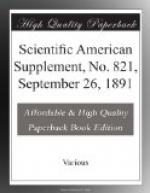and was dispensed with whenever practicable. The
crude paper is the foundation of the roofing paper.
The qualities of a good, unadulterated paper have
already been stated. At times, the crude paper
contains too many earthy ingredients which impair the
cohesion of the felted fibrous substance, and which
especially the carbonate of lime is very injurious,
as it readily effects the decomposition of the coal
tar. The percentage of wool, upon which the durability
of the paper depends very largely, is very small in
some of the paper found in the market. In place
of woolen rags, cheap substitutes have been used,
such as waste, which contains vegetable fibers.
Since this cannot resist the decomposition process
for any length of time, it is evident that the roofing
paper which contains a noticeable quantity of vegetable
fibers cannot be very durable. To judge from the
endeavors made to improve the coal tar, it may be
concluded that this material does not fully comply
with its function of making the roofing paper perfectly
and durably waterproof. The coal tar, be it either
crude or distilled, is not a perfect impregnating
material, and the roofing paper, saturated with it,
possesses several defects. Let us in the following
try to ascertain their shortcomings, and then express
our idea in what manner the roofing paper may be improved.
It was previously mentioned that every tar roofing
paper will, after a greater or smaller lapse of time,
assume a dry, porous, friable condition, caused by
the volatilization of a part of the constituents of
the tar. This alteration is materially assisted
by the oxygen of the air, which causes the latter
to become resinous and exerts a chemical influence
upon them. By the volatilization of the lighter
tar oils, pores are generated between the fibers of
the roofing paper, into which the air and humidity
penetrate. In consequence of the greatly enlarged
surface, not only the solid ingredients of the tar,
which still remain unaltered, are exposed to the action
of the oxygen, but also the fibers of the roofing
paper are exposed to decomposition. How destructive
the alternating influence of the oxygen and the atmospheric
precipitations are for the roofing paper will be shown
by the following results of tests. It will have
been observed that the rain water running from an
old paper roof, especially after dry weather, has
a yellowish, sometimes a brown yellow color. The
supposition that this colored rain water might contain
decomposition products of the roofing paper readily
prompted itself, and it has been collected and analyzed
at different seasons of the year. After a period
of several weeks of fair weather during the summer,
rain fell, and the sample of water running from a
roof was caught and evaporated; the residue when dried
weighed 1.68 grammes. It was of a brownish black
color, fusible in heat and readily soluble, with a
yellow brown color in water. The dark brown substance
readily dissolved in ammonia, alcohol, dilute acid,




